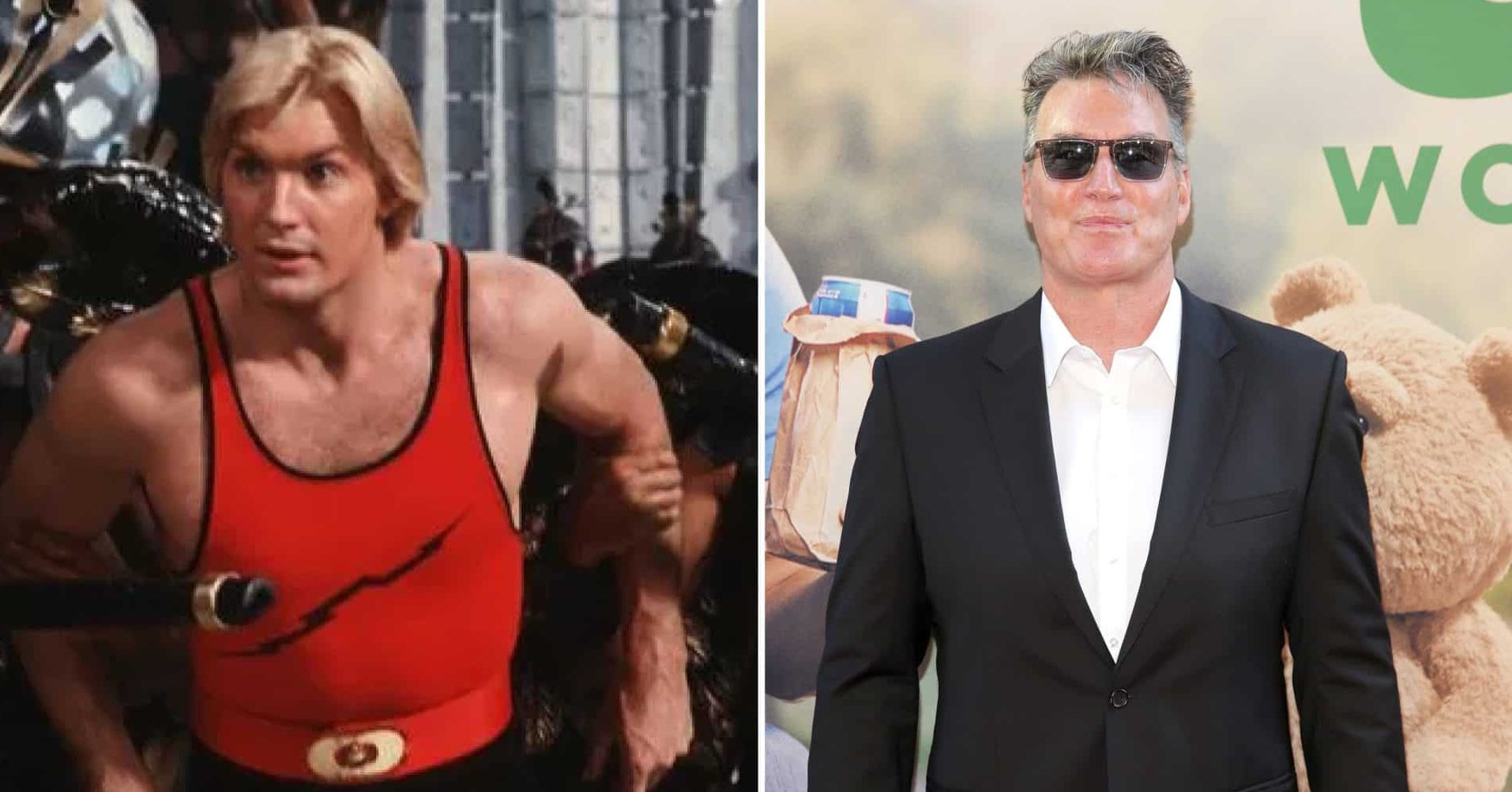There are plenty of old films that are loved today, but weren’t so successful when they first came out. A great example of this is Flash Gordon, the ultra-camp space opera which has been a beloved family favourite for decades – despite the fact that it was a bit of a flop back in 1980.
It might not have set the box office alight, but Flash Gordon was a huge part of most of our childhoods thanks to VHS and television – and here are some facts about the film which you might not have known.
30. George Lucas tried to get the rights to make it before moving on to Star Wars
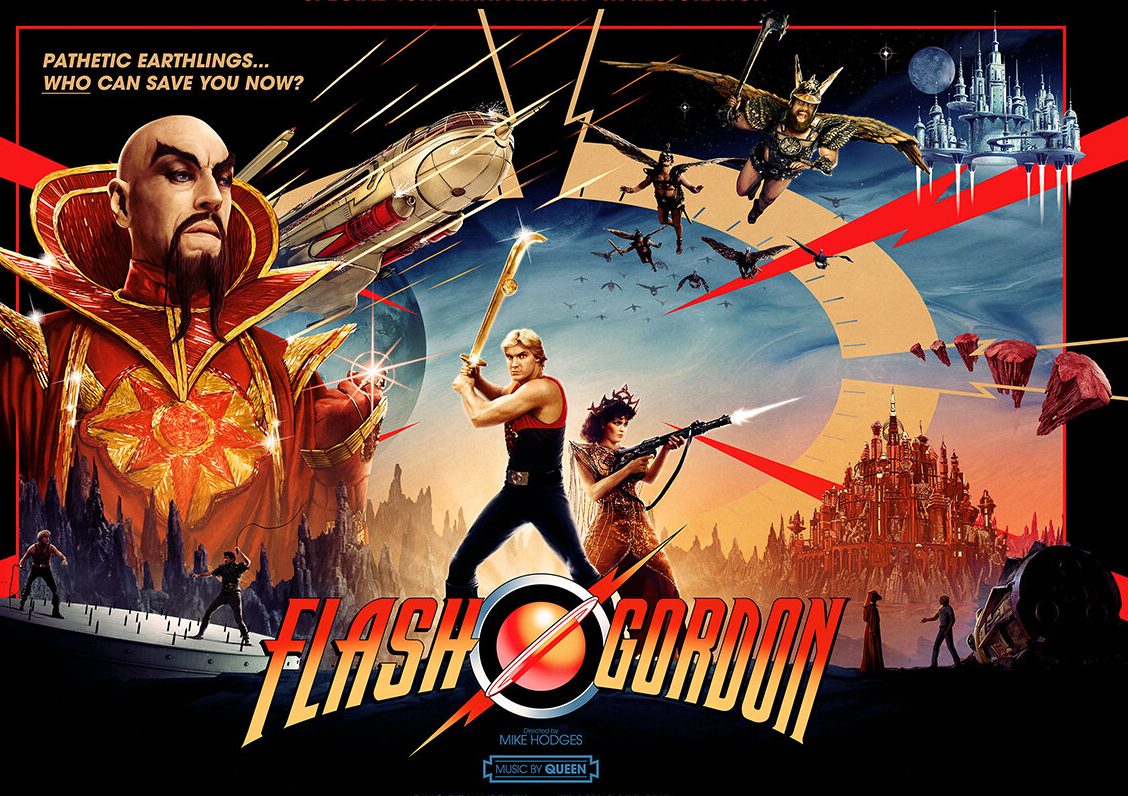
After making his first two films, THX-1138 and American Graffiti, writer-director George Lucas was keen to make a movie of Flash Gordon, being a big fan of the original 1930s comic strip by Alex Raymond and the subsequent movie serials starring Buster Krabbe. However, the rights to Flash Gordon were owned by producer Dino De Laurentiis, who rejected Lucas’ offer to direct a film.
As a result of this, Lucas abandoned his Flash Gordon plans and came up with his own original space opera entitled Star Wars – and, as you’re probably aware, this film became the biggest box office hit of all time in 1977, kickstarting a franchise which endures to this day. Ironically, it was the success of Star Wars which prompted Dino De Laurentiis to finally get Flash Gordon into production.
29. Federico Fellini, Sergio Leone and Nicolas Roeg were all considered to direct

For a film often considered a guilty pleasure, Flash Gordon had some prestigious filmmakers attached at different times. Early on, producer De Laurentiis pursued the acclaimed and influential Italian filmmaker Federico Fellini to direct Flash Gordon, without success. After this, another legendary Italian director, Sergio Leone, was in line for the job, but this didn’t work out either.
The filmmaker who came closest to directing Flash Gordon was esteemed British director Nicolas Roeg (Don’t Look Now, The Man Who Fell to Earth). However, after a year of pre-production work, De Laurentiis felt Roeg’s approach to the project was wrong, and he was finally replaced with another Brit, Mike Hodges (Get Carter).
28. The cast contains four actors from the James Bond franchise

Although no one knew it at the time, four actors who appear in Flash Gordon would go on to be part of the James Bond series. The most significant of these is of course Timothy Dalton, who plays alien anti-hero Prince Barin. Dalton went on to be the fourth actor to play Bond in The Living Daylights and Licence to Kill.
In addition, Emperor Ming actor Max Von Sydow would play Blofeld in unofficial Bond movie Never Say Never Again, whilst Hans Zarkov actor Topol would play a small role in For Your Eyes Only. Finally there’s Robbie Coltrane, who appears very briefly in Flash Gordon’s earthbound scenes; he would later play Valentin Zukovsky in GoldenEye and The World is Not Enough.
27. Arnold Schwarzenegger and Kurt Russell were both contenders for the title role
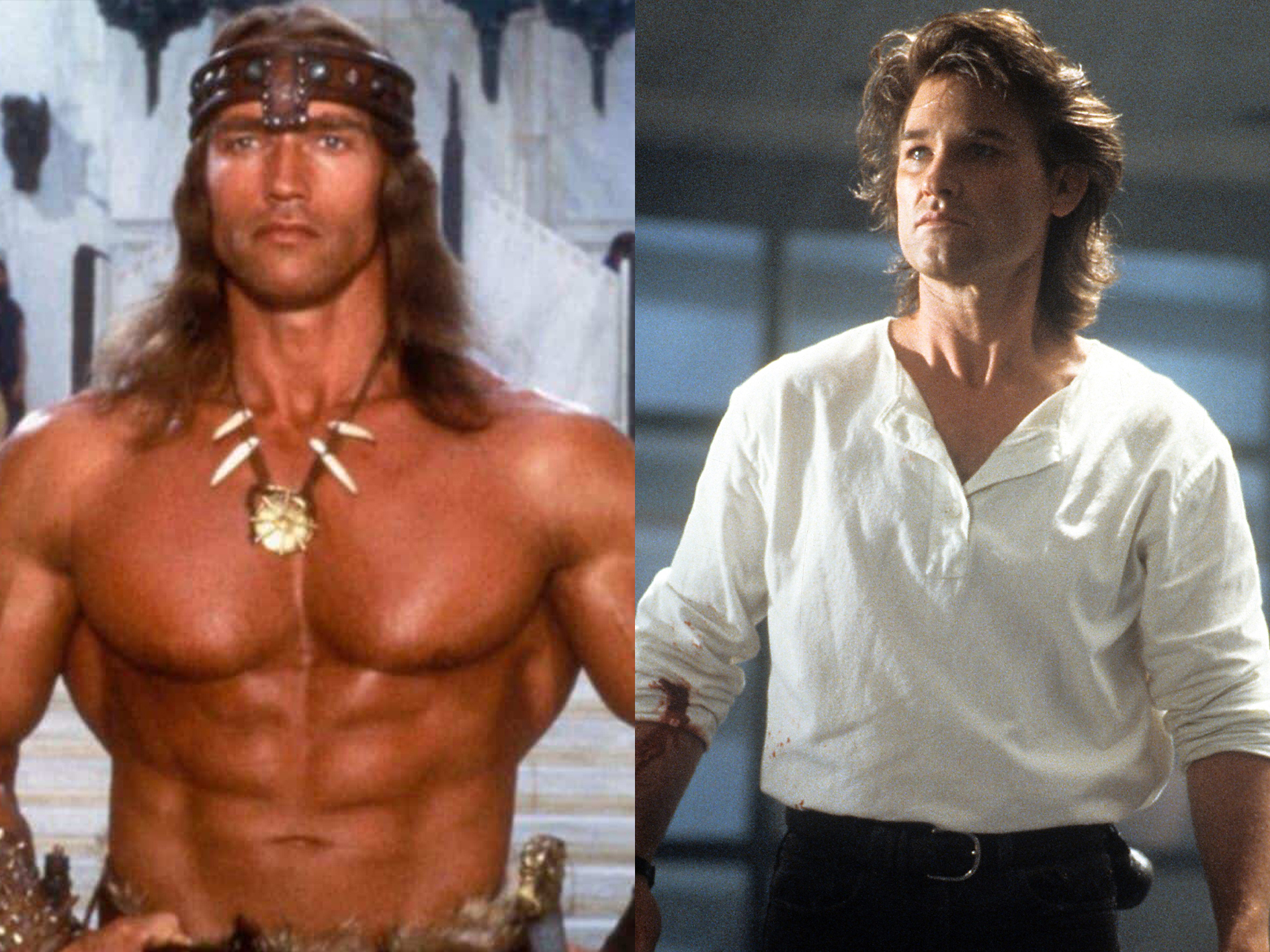
Flash Gordon is a literal out-of-this-world adventure, so the filmmakers needed a suitably superhuman leading man. To this end, they briefly considered Arnold Schwarzenegger, who had yet to successfully make the move from bodybuilding champion to major movie star. Ultimately they decided against the Austrian Oak – although De Laurentiis would remember him for Conan the Barbarian two years later.
Kurt Russell (still best known at the time for his early films as a child actor with Disney) was also a contender to play Flash, although he was reportedly less than impressed with the script and felt Flash was a lifeless character. Turning the part down, Russell instead took the part of Snake Plissken in Escape from New York, which helped launch him as an 80s action hero.
26. Blue Peter presenter Peter Duncan has a small role

Back in the 80s, younger viewers in Britain were always taken aback during the scenes set on the forest world of Arboria, as there is a familiar face among the Tree Men: Peter Duncan, the young initiate who is stung by the wood beast and soon thereafter begs Prince Barin for a merciful death with the cry, “spare me the madness!”
Peter Duncan was well known to kids of the time as a presenter on long running Children’s BBC show Blue Peter. He later hosted his own spin-off show, Duncan Dares. Nor is Duncan the only familiar face from 80s TV in Flash Gordon: another of the Tree Men is Richard O’Brien of The Rocky Horror Picture Show, later the host of game show The Crystal Maze.
25. Dino De Laurentiis had never heard of Queen before hiring them for the Flash Gordon soundtrack
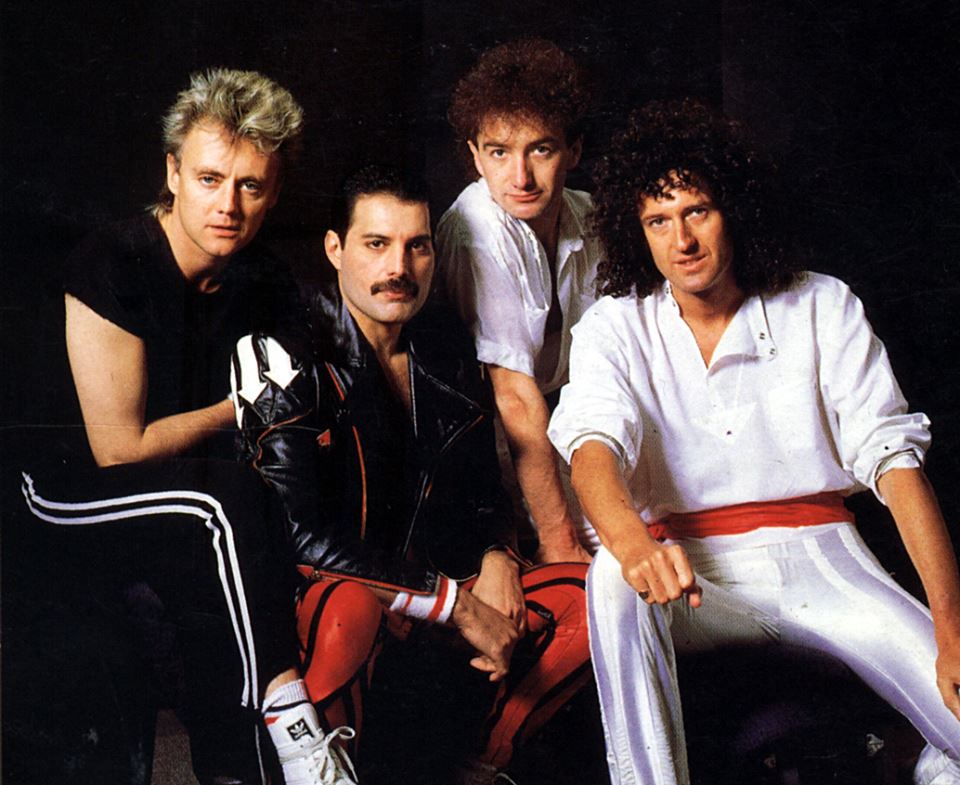
Flash Gordon was something of a groundbreaking film in terms of its soundtrack. Although plenty of movies had used rock music before, there hadn’t been many instances of a rock band being hired to compose and perform the entire score of a movie. Enter Queen, who were hired for Flash Gordon in collaboration with composer Howard Blake.
However, the idea of hiring Queen came from members of producer Dino De Laurentiis’ staff, and not De Laurentiis himself. Reportedly the producer had never heard of the beloved British band and asked, “who are The Queens?” Still, the Flash Gordon soundtrack proved a good career move for Queen, who would provide the soundtrack to another cult 80s hit several years later: 1986’s Highlander.
24. Max Von Sydow’s Ming costume was so heavy, he had to lie down between takes
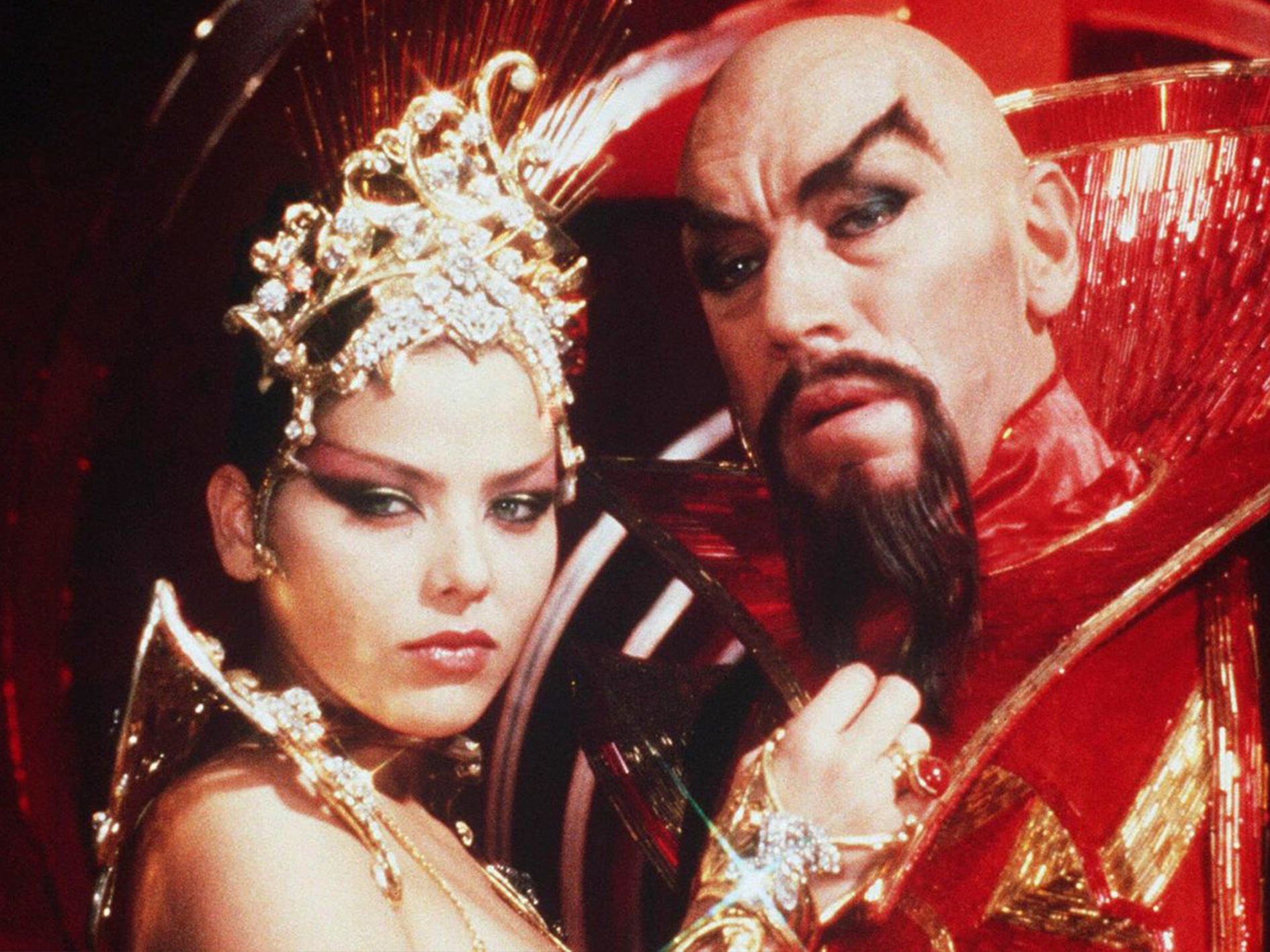
Max Von Sydow makes a big impression as Flash’s arch-enemy, Emperor Ming the Merciless of planet Mongo. While there is of course a lot to be said for the great Von Sydow’s performance in the role, there’s also the matter of his look: shaved head, carefully styled goatee beard with pointy eyebrows to match – and of course, his costume.
Ming’s striking red outfit, complete with a large and ornate headpiece, was the work of costume designer Danilo Donati, inspired by Alex Raymond’s original designs. As impressive as this costume might have bene, it took its toll on Von Sydow due to its significant weight. Unfortunately its construction meant the actor couldn’t sit down whilst in costume, so to relax between takes he had to lie down flat on a board.
23. A lot of Sam J. Jones’ dialogue was overdubbed when he quit the film during post-production

Playing the title role in Flash Gordon should have been a major career turning point for Sam J. Jones, but things went sour between the up-and-coming actor and his seasoned producer Dino De Laurentiis. Somewhere along the line the two men had a major falling out, which led to Jones walking away from the film before post-production was complete.
For many years, it has been rumoured that the entirety of Jones’ dialogue was overdubbed by another actor, but this isn’t entirely accurate. Some, but not all of Jones’ own dialogue had been mixed before the actor quit; in his absence another actor overdubbed some of his remaining dialogue. It wasn’t until 2012 that the other voice of Flash was revealed to be British actor Peter Marinker.
22. Plans for a Flash Gordon trilogy were scrapped when the film flopped

Famously, Flash Gordon ends with the suggestion that the villainous Ming has survived, and the climactic title card reads, ‘The End?’ As this might suggest, it had been intended that sequels would ensue, but these plans were torpedoed both by the departure of Jones and, more significantly, the film’s financial under-performance.
Having cost close to $27 million to make and even more to market, Flash Gordon made less than $50 million at the global box office. Generally a film needs to make back double its production budget to at least break even, so this rendered Flash Gordon a flop, despite the fact that it performed well in both Britain and Italy.
21. Neither Sam Jones nor Melody Anderson have their natural hair colour in the film
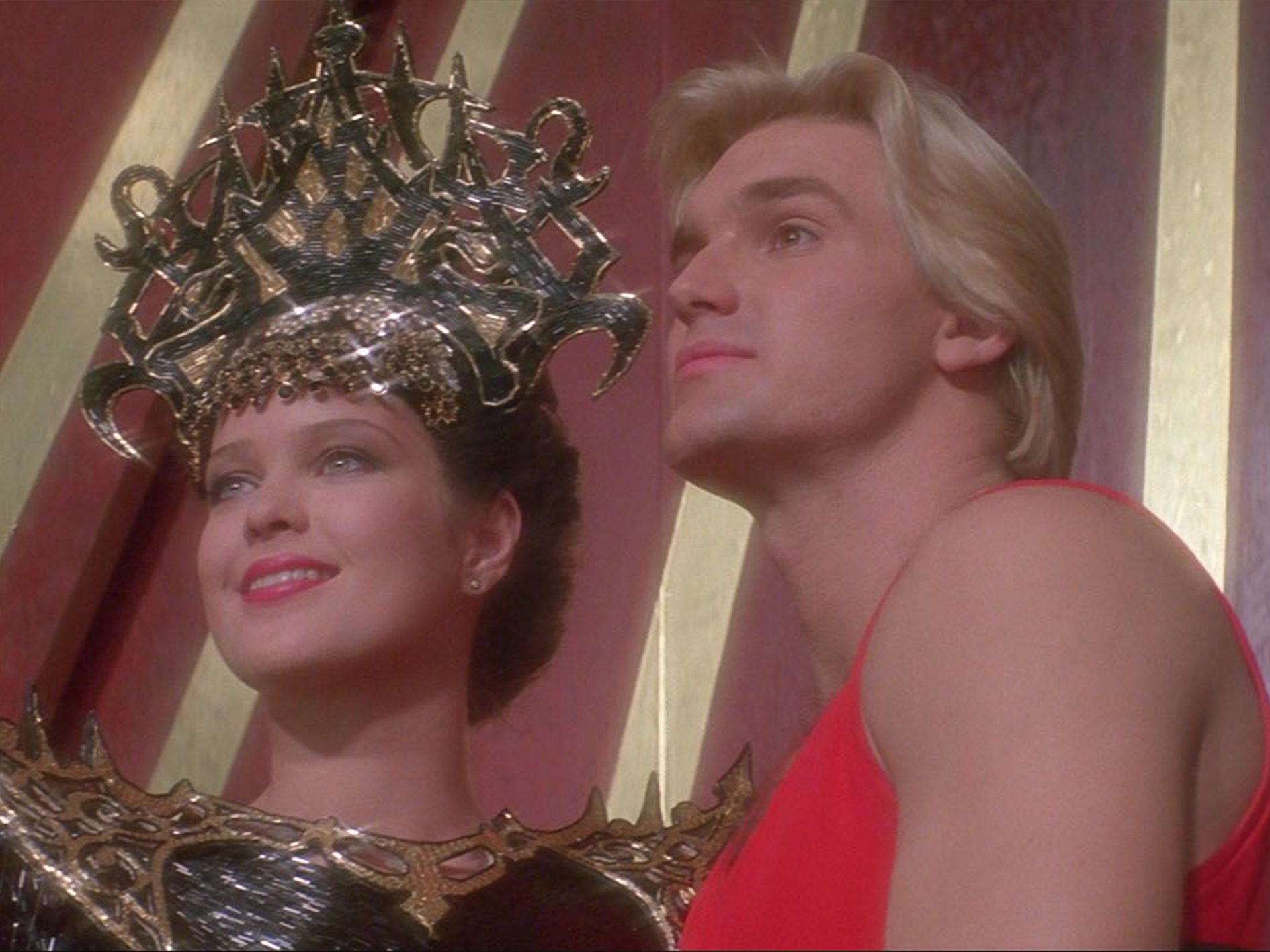
As anyone who’s ever seen Flash Gordon will undoubtedly remember, the film centres on blonde-haired pro-football player Flash and raven-haired journalist Dale Arden, who fall in love after finding themselves unexpectedly hurled beyond the reaches of the known universe. As is so often the case in the movies, a little bit of trickery was required here.
In reality, Flash actor Sam J. Jones is not a blonde; his hair is considerably darker, and had to be bleached specifically for the role. The opposite is true of Dale actress Melody Anderson; she is a natural blonde, and so had to have her hair dyed black. Originally, Jones had also been asked to wear blue contact lenses, but this was scrapped as he found them too uncomfortable.
20. Screenwriter Lorenzo Semple Jr. regretted making the film tongue-in-cheek

Producer Dino De Laurentiis was confident from the get-go that the best way to bring Flash Gordon to the screen was in a campy, tongue-in-cheek manner. With this in mind, De Laurentiis hired a screenwriter with expertise in that field: Lorenzo Semple Jr, a writer on 1960s TV series Batman and its big screen spin-off. Semple had already written two produced scripts for De Laurentiis: Three Days of the Condor and 1976’s King Kong.
Semple would later express regret about the comedic approach taken with Flash Gordon: “in hindsight, I realize it was a terrible mistake. We kept fiddling around with the script, trying to decide whether to be funny or realistic… Dino had a vision of a comic-strip character treated in a comic style. That was silly, because Flash Gordon was never intended to be funny.”
19. Melody Anderson spent six hours in make-up for a dream sequence that was never filmed
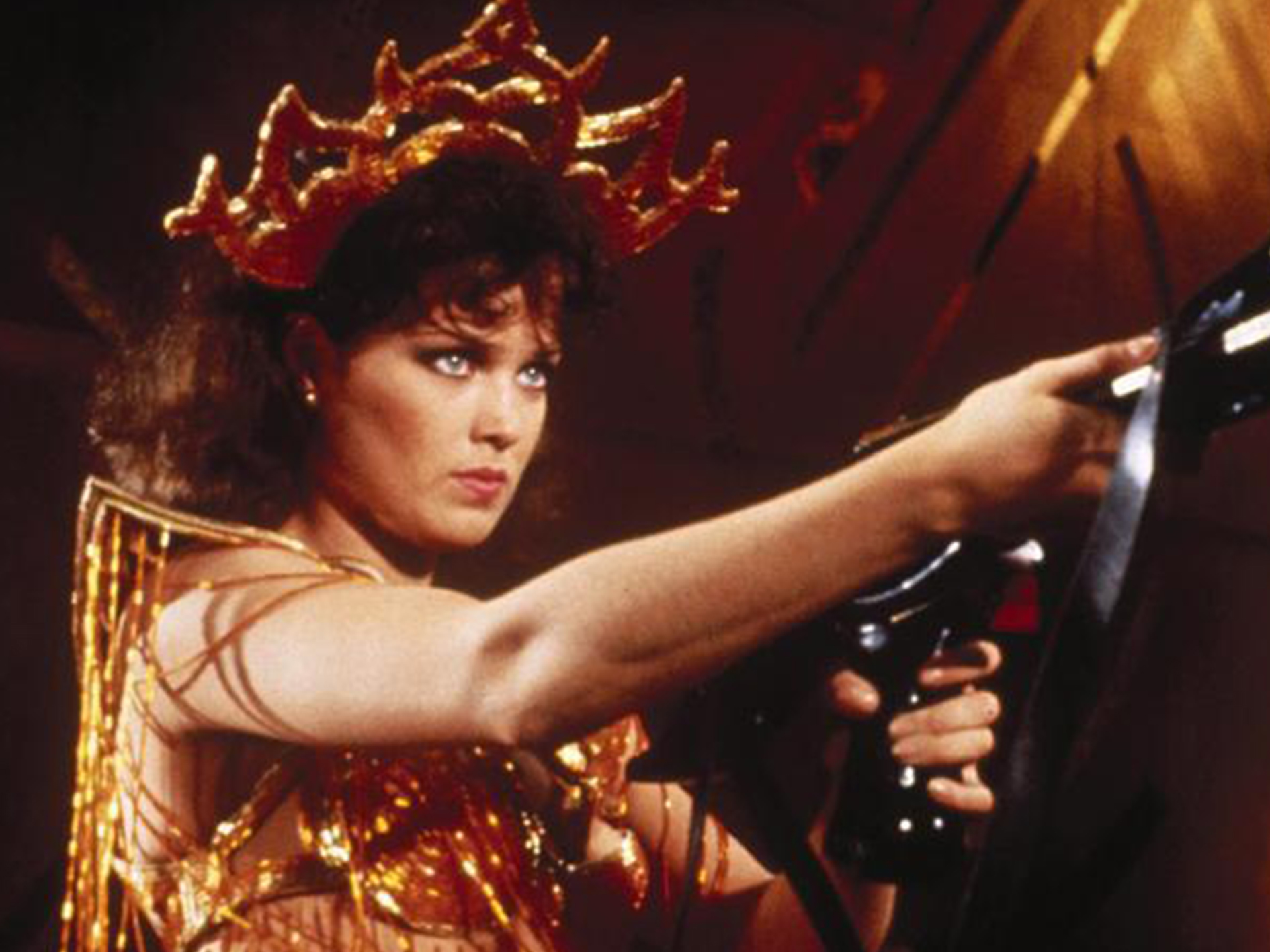
There were a great many powerful imaginations at play on the set of Flash Gordon, and sometimes this unrestrained creativity got a little out of hand. One such instance came when Melody Anderson was put through six hours of make up in order to shoot a dream sequence in which she transformed into a giant spider. For this, the actress was covered in green body paint and fitted with fake eyes, fangs and more.
If this sounds unfamiliar, that’s because there’s no such scene in the movie; in fact, there was no such scene in the screenplay. It’s not clear exactly whose idea it was or who gave the go-ahead for Anderson to spend all that time getting made up, but when director Mike Hodges saw the end result he is said to have remarked, “This is wonderful! But we can’t use this, it has absolutely nothing to do with the script!”
18. Brian Blessed kept blowing takes by making “pew-pew” noises in battle scenes

Arguably the most memorable performance in Flash Gordon comes from Brian Blessed as Prince Vultan. In his role as leader of the Hawkmen, Blessed brings new meaning to the words ‘larger than life,’ fully embracing the cartoonish excess of the material – and according to the actor himself, this proved to be a problem on set.
By the actor’s own admission, he blew a lot of takes because he just couldn’t help making “pew-pew” noises whilst shooting the laser battle sequences. Reportedly this resulted in costly delays, as some shots in the battle sequences took many hours to set up. Still, Blessed says he wasn’t the only offender in this regard, claiming that Sam J. Jones also inadvertently let out the odd “pew-pew.”
17. Sam J. Jones ad-libbed Flash’s “Yeah!” jump

As is often the case in movies, some of Flash Gordon’s most memorable moments did not originate in the script, but were figured out by the director and the cast on set. One such moment came following the defeat of Ming, when we see Flash from the point of view of a floating robot. Apparently no one was sure how to conclude this scene, so Jones suggested Flash jump for joy and let out a celebratory “Yeah!”
Nor was this the only case of a well-loved moment from Flash Gordon being improvised on set. During the scene when Flash takes on Ming’s guards utilising his skills as a quarterback, it was Melody Anderson herself who suggested she should become his cheerleader, clapping “go, Flash, go!” In another scene, Brian Blessed ad-libbed a moment when he pinches Dale’s bottom; Melody Anderson’s shocked reaction is genuine.
16. Stephen Sommers, Matthew Vaughn and Taikia Waititi have been linked to a reboot
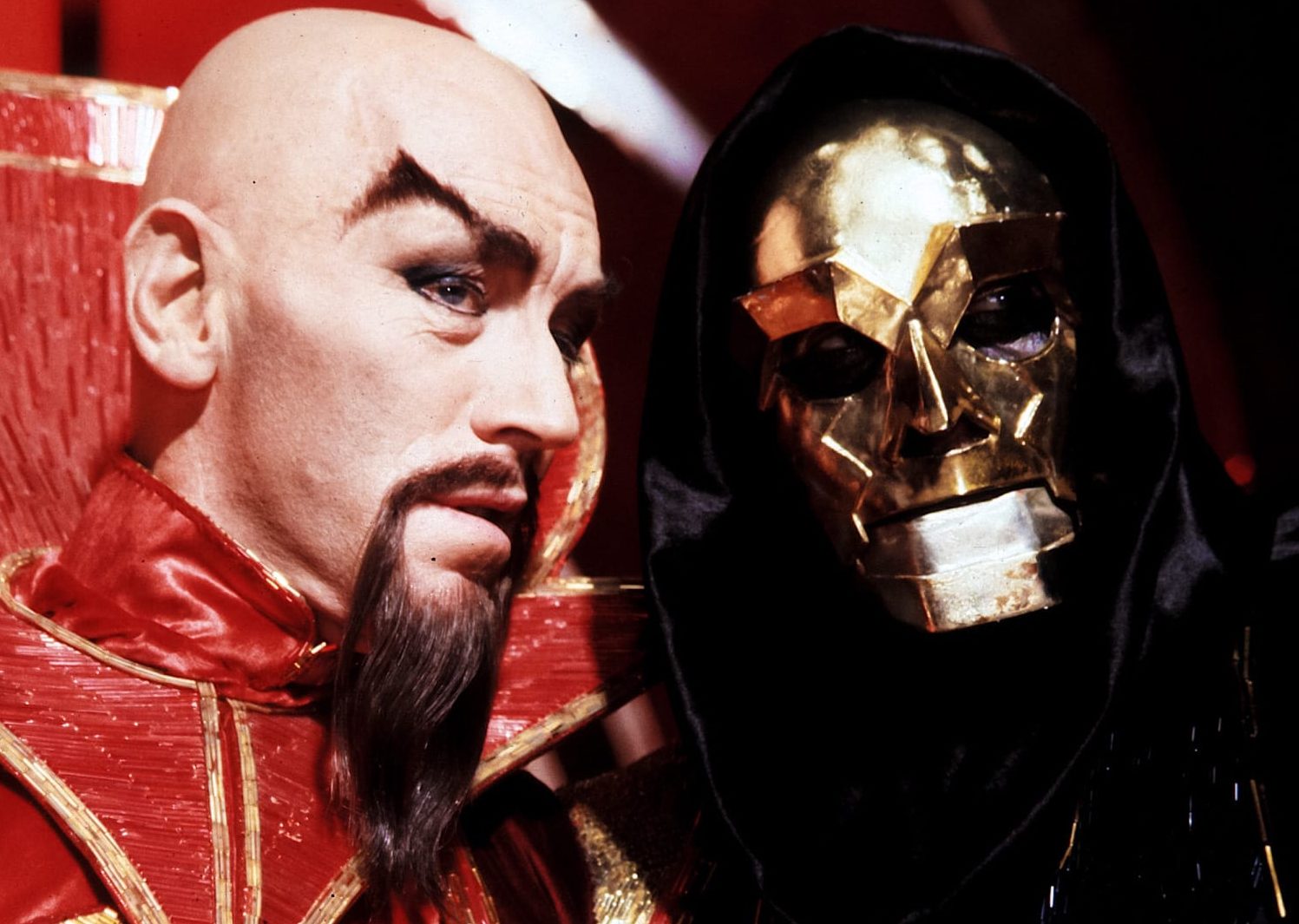
Even though the film didn’t exactly set the world on fire at the time, Flash Gordon has long since been embraced as an all-time favourite of many, earning its place in the pantheon of beloved 80s movies. This of course means that, for many years, Hollywood has been keen to bring Flash back to the screen again; but while the character appeared in cartoon series Defenders of the Earth and a short-lived live action series on the Sci-Fi Channel, no new movie has happened yet.
Rumblings of a Flash Gordon reboot first began back in 2004, when Stephen Sommers writer-director of The Mummy, was reported to be working on the film. Later, Matthew Vaughn (Kick-Ass, Kingsman) was also reported to be in talks to make a Flash Gordon movie. Most recently, Taikia Waititi (whose Marvel movie Thor: Ragnarok was hugely influenced by Flash Gordon) has been linked to the project, but nothing has been confirmed to date.
15. Brian Blessed claims it was the favourite film of Queen Elizabeth
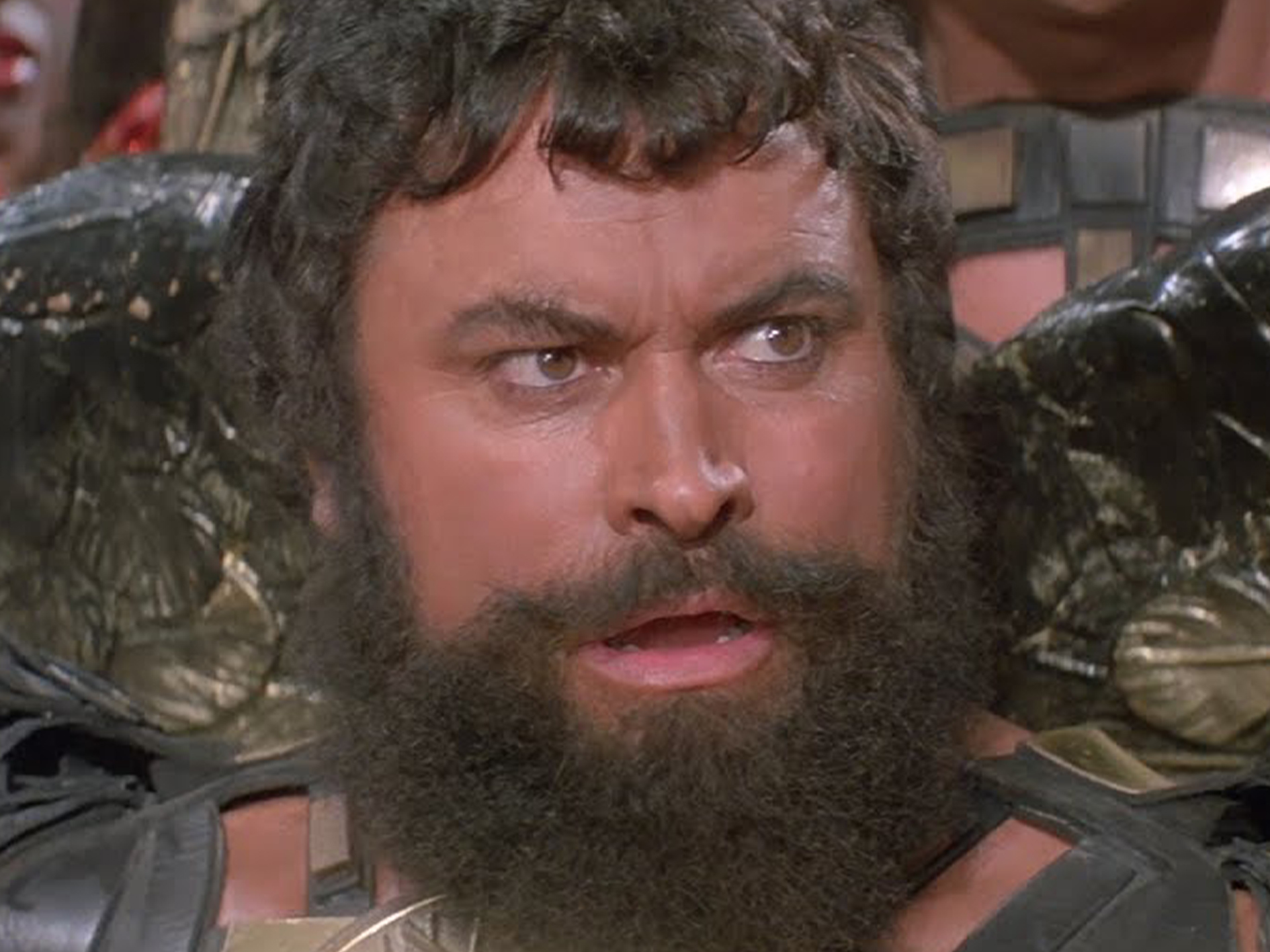
Flash Gordon has always been hugely popular in the United Kingdom, where it was a huge hit in cinemas and on VHS, and has long been staple family TV viewing at Christmas and other major holidays. According to Brian Blessed, one among the many British families with a great love for the film is the Royal Family – and this included the late Queen Elizabeth II herself.
Blessed told Yahoo! Movies UK in 2020, “The Queen, it’s her favourite film, she watches it with her grandchildren every Christmas.” Blessed even claims Her Majesty has asked him to deliver his most famous line for her, saying the Queen asked him, “You know, we watch Flash Gordon all the time, me and the grandchildren… would you mind saying ‘Gordon’s alive’?”
14. An acclaimed documentary explores what happened to Sam J. Jones after Flash Gordon

The sudden rise and equally sudden fall of Sam J. Jones has long been something that film fans have puzzled over. Whilst the actor has racked up more than 80 screen credits (the most recent of which was in 2021), he has never appeared in another film as well-loved as Flash Gordon. Jones’ other most notable performance was in 2012 comedy Ted, in which he played a caricature of himself.
The highs and lows of Jones’ post-Flash Gordon career were chronicled in the 2017 documentary Life After Flash. Directed by Lisa Downs, the film details both the story of Jones’ experience on the film, his subsequent professional woes, and his gradual rebirth as a cult icon. Comic writer Mark Millar praised Life After Flash as “just maybe the best doc about Hollywood I’ve ever seen.”
13. Aura’s pet is named ‘Fellini’ in reference to the director who turned the film down

As mentioned earlier, Flash Gordon’s director Mike Hodges only landed the job after a number of other directors declined, the first of whom was the noted Federico Fellini. The Italian filmmaker, who was 60 years old at the time, is regularly named among the greatest and most influential directors in the history of world cinema, his most celebrated works including La Dolce Vita and 8½.
Flash Gordon producer Dino De Laurentiis may have been unable to lure Fellini to take on the project, but the filmmakers still found a way to include a cheeky nod to the esteemed filmmaker. In a detail that probably wouldn’t fly today, Ornella Muti’s Princess Aura has a dwarf ‘pet’ played by Deep Roy – and this character is named Fellini.
12. Queen later quoted Brian Blessed’s dialogue in Highlander song Who Wants To Live Forever
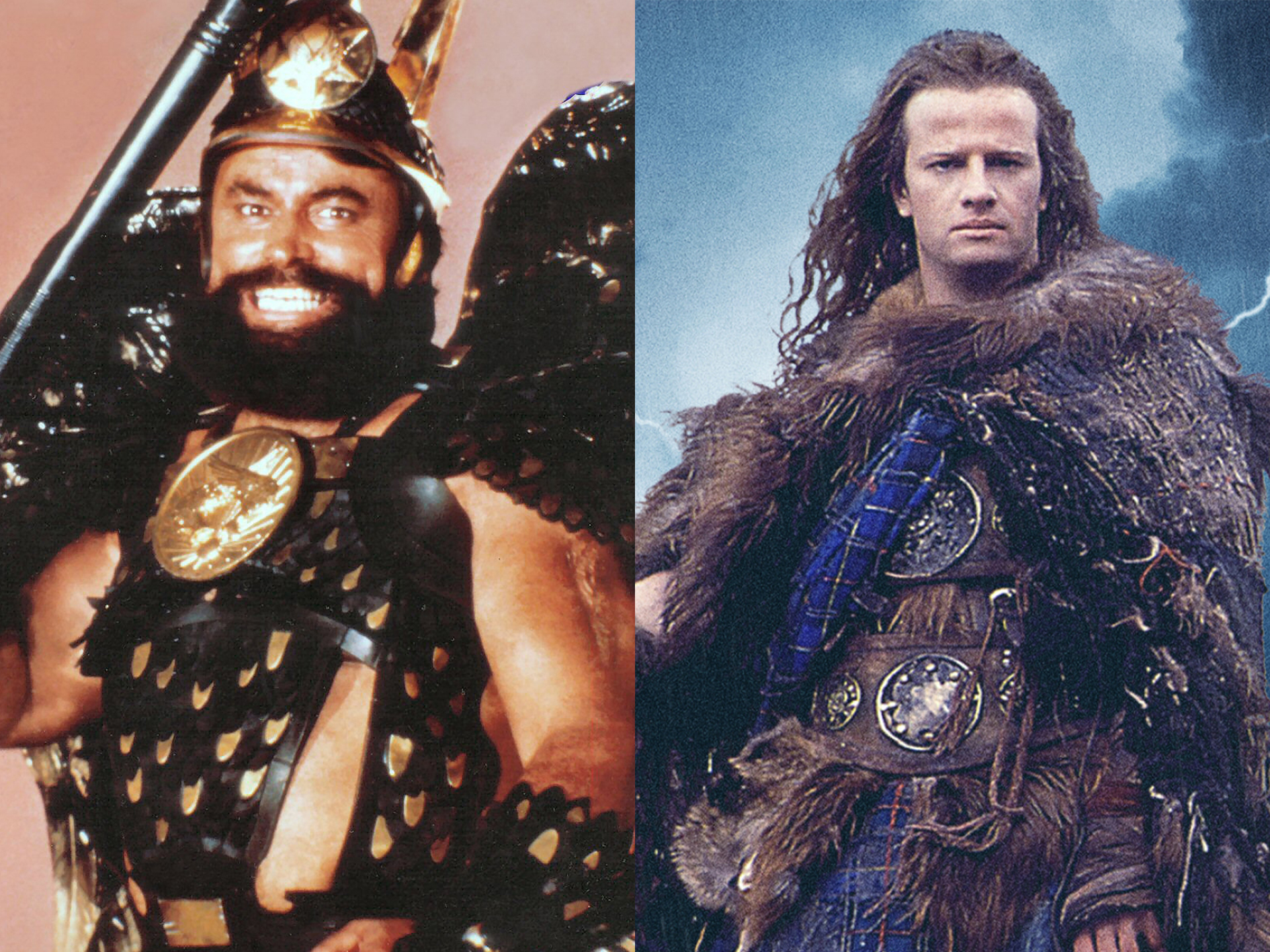
When British rock band Queen were later hired to provide music for another movie, 1986 fantasy adventure Highlander, one of the songs they came up with refers back to Flash Gordon. The song in question is the ballad Who Wants To Live Forever, which takes its title directly from one of Brian Blessed’s lines as Prince Vultan in the 1980 film.
This was an appropriate sentiment for Highlander, as the film centres on a race of immortal beings living among humanity. Who Wants To Live Forever became one of Queen’s best loved songs, and was one of several written and recorded specifically for the Highlander soundtrack, others including A Kind of Magic and Princes of the Universe.
11. Producer Dino De Laurentiis had already made two of the first major comic book movies
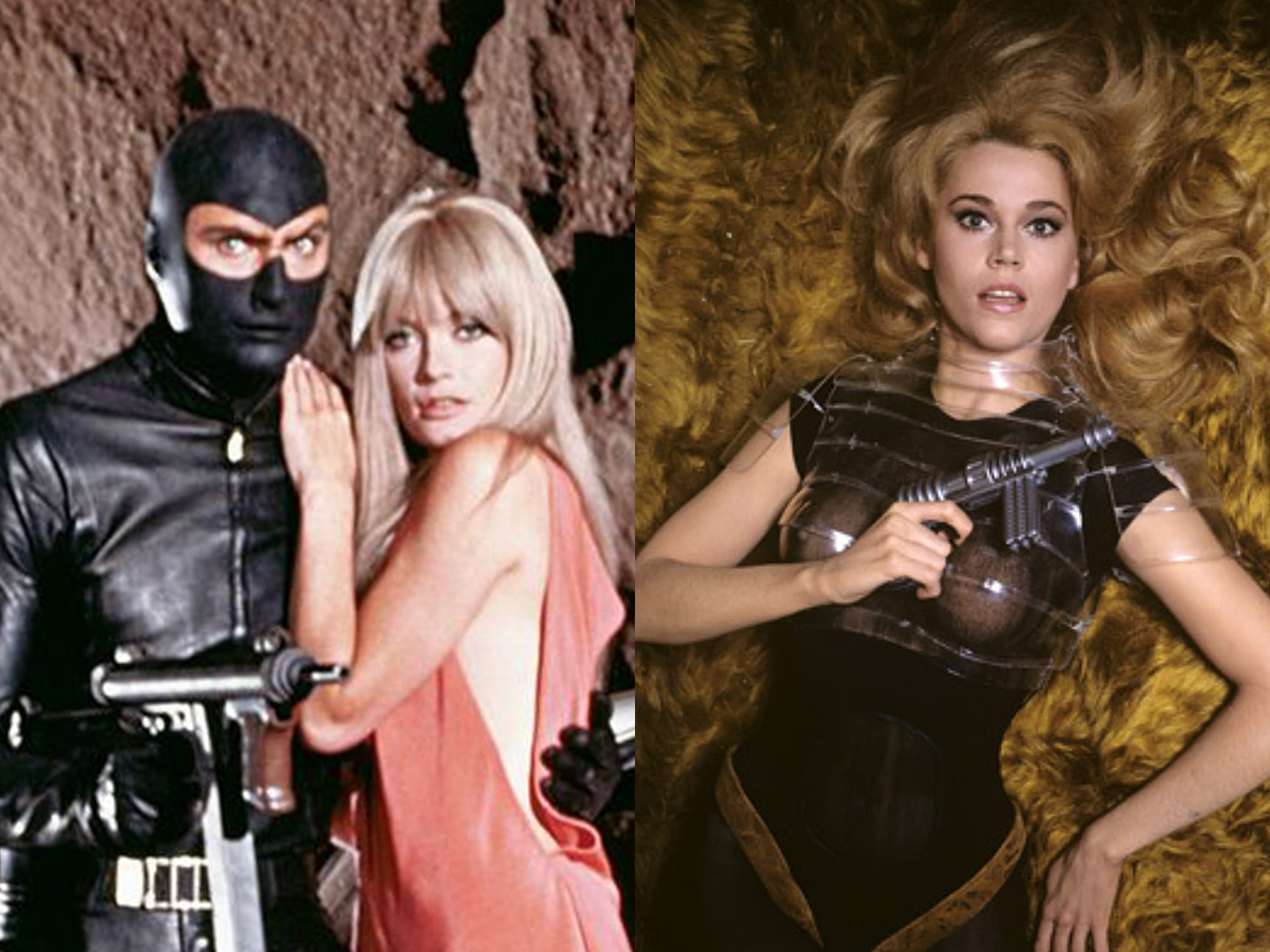
As we all know, big budget movies based on comic books are ten-a-penny in the early 21st century, but in decades gone by such films were not so commonplace. In fact, Flash Gordon producer Dino De Laurentiis could be considered something of a pioneer in this field, as more than a decade before that 1980 sci-fi spectacular, he had produced two other films based on comic book characters.
The first of these was Danger: Diabolik, a crime thriller based on Italian comic strip Diabolik, which starred John Philip Law as a masked thief. This was released in early 1968, followed later that same year by another, far better known De Laurentiis production: Barbarella, the sci-fi comedy adventure based on the French comic, which cast Jane Fonda as the spacefaring adventuress of the title, with a similarly camp tone to Flash Gordon.
10. There was a Flash Gordon tie-in comic book, novelisation and Atari game
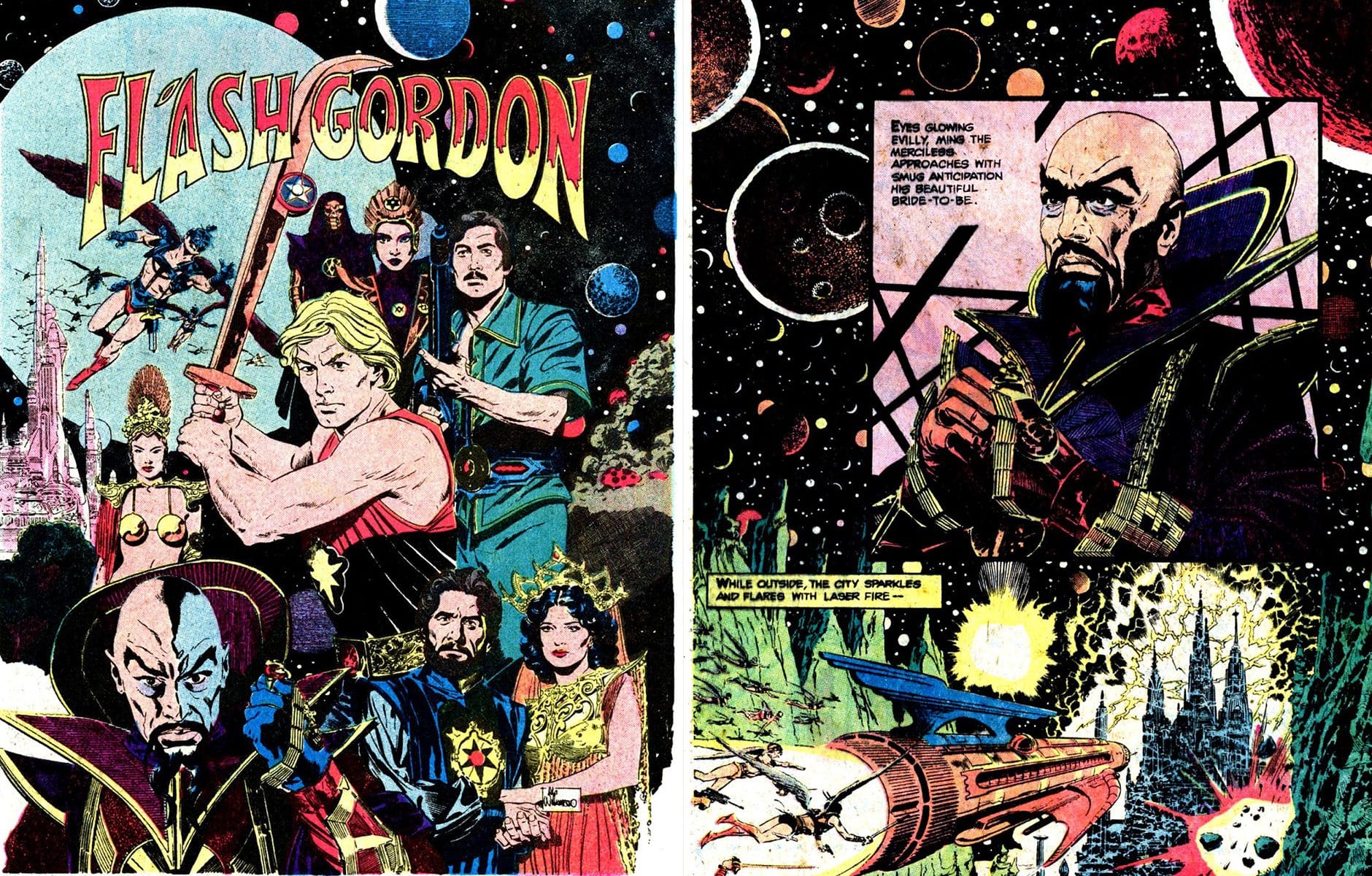
Hopes were high that Flash Gordon would repeat the success of Star Wars, and one thing that George Lucas’ film demonstrated was the power of merchandising. With this in mind, the Flash Gordon marketing team made a point of producing as much high-profile tie-in material as possible. 1980 saw a three-issue comic book adaptation of the film from Golden Press comics, as well as a novelisation.
There was also a Flash Gordon video game, released for the Atari 2600 in 1983 (despite the fact that the film had been deemed a flop by then). Perhaps surprisingly, there were no Flash Gordon movie toys – although Mattel had produced a range of action figures in 1979 to tie in with largely forgotten TV cartoon series The New Adventures of Flash Gordon.
9. Sam J. Jones kept getting in fights during filming
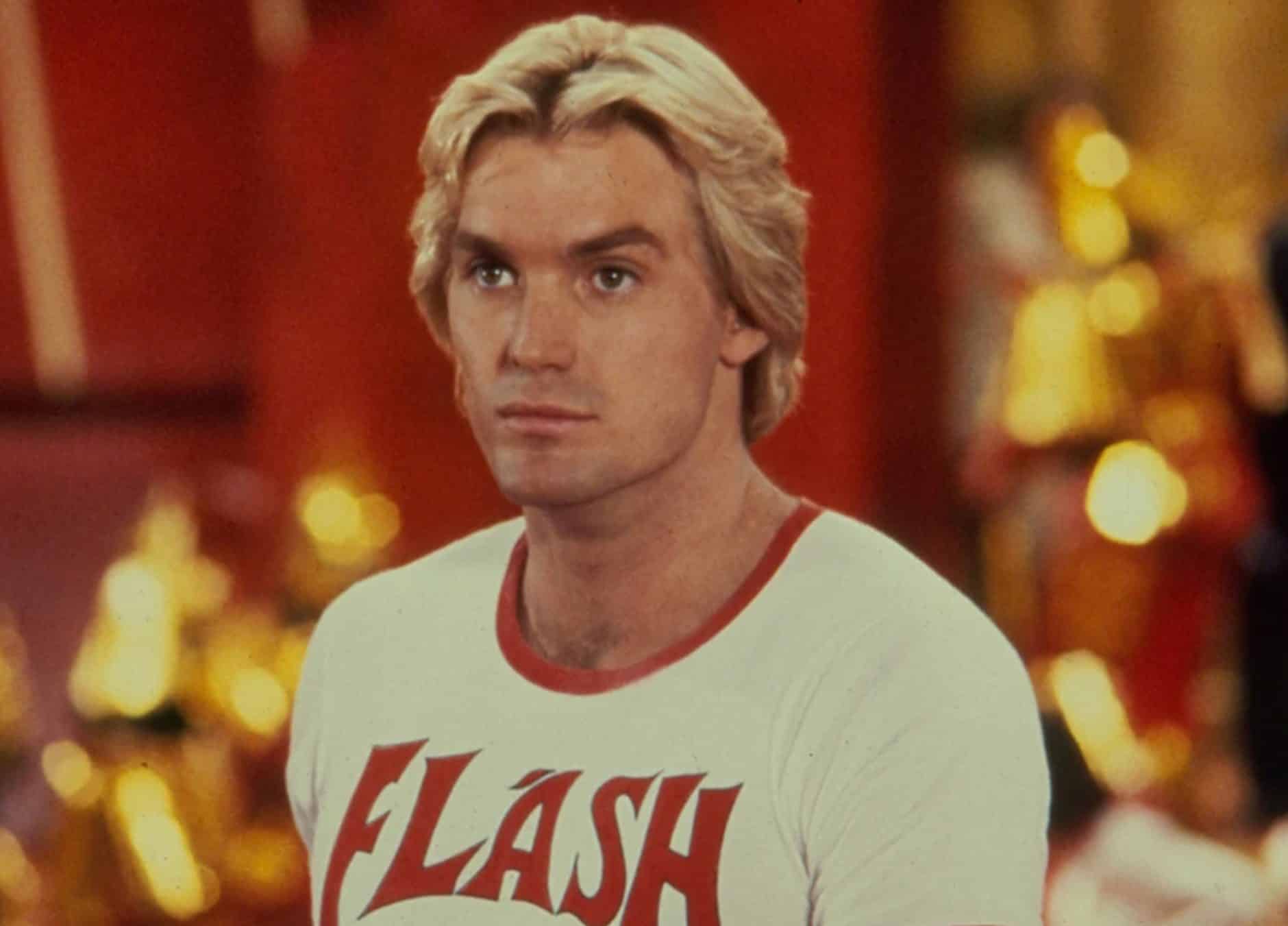
Sam J. Jones was a bit of a loose cannon, which in part explains why his career never took off post-Flash. According to producer Dino De Laurentiis, Jones would often get into random fights and brawls during filming. Writing in his biography Dino: The Life and Films of Dino De Laurentiis, the producer recalled having to visit his leading man in the hospital after one particularly nasty fight.
When he arrived, De Laurentiis barged into the operating room to make sure the doctors had fixed Jones’ face properly and they hadn’t left a scar. Sadly, after that, Jones kept causing trouble and in the end he left the production and never returned. Rather than panicking, the producer turned to his director Mike Hodges and said, “We’ll keep going, with the very best stand-in you can find.”
8. Flash was originally a polo player
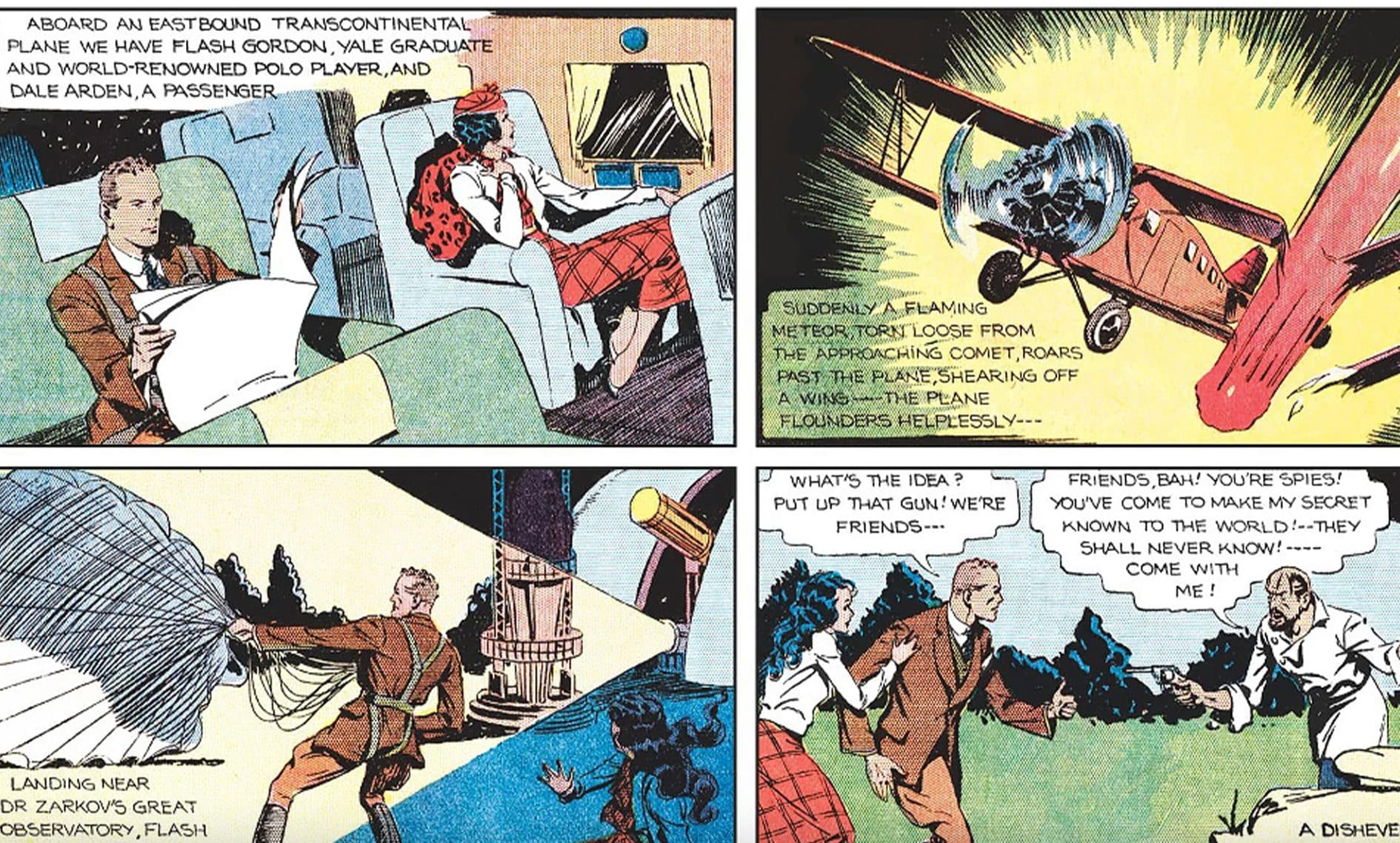
Most of the key plot points in Flash Gordon come direct from writer/artist Alex Raymond’s original comic strip: Flash is a famous American sportsman who is on a plane with Dale Arden when they crash-land near the lab of Dr Hans Zarkov, who then forces them to board his rocket to space. However, there’s one notable difference.
In the movie, Flash Gordon introduces himself as the quarterback for the New York Jets. However, in the original comic strip Flash played polo. This was a popular sport back in the 1930s, but as sporting tastes had changed by 1980, it was decided Flash should instead be a football player. Just as well, really; can you imagine Flash fighting Ming’s guards using his polo skills?
7. Flash and Dale were originally supposed to meet in a Canadian resort town
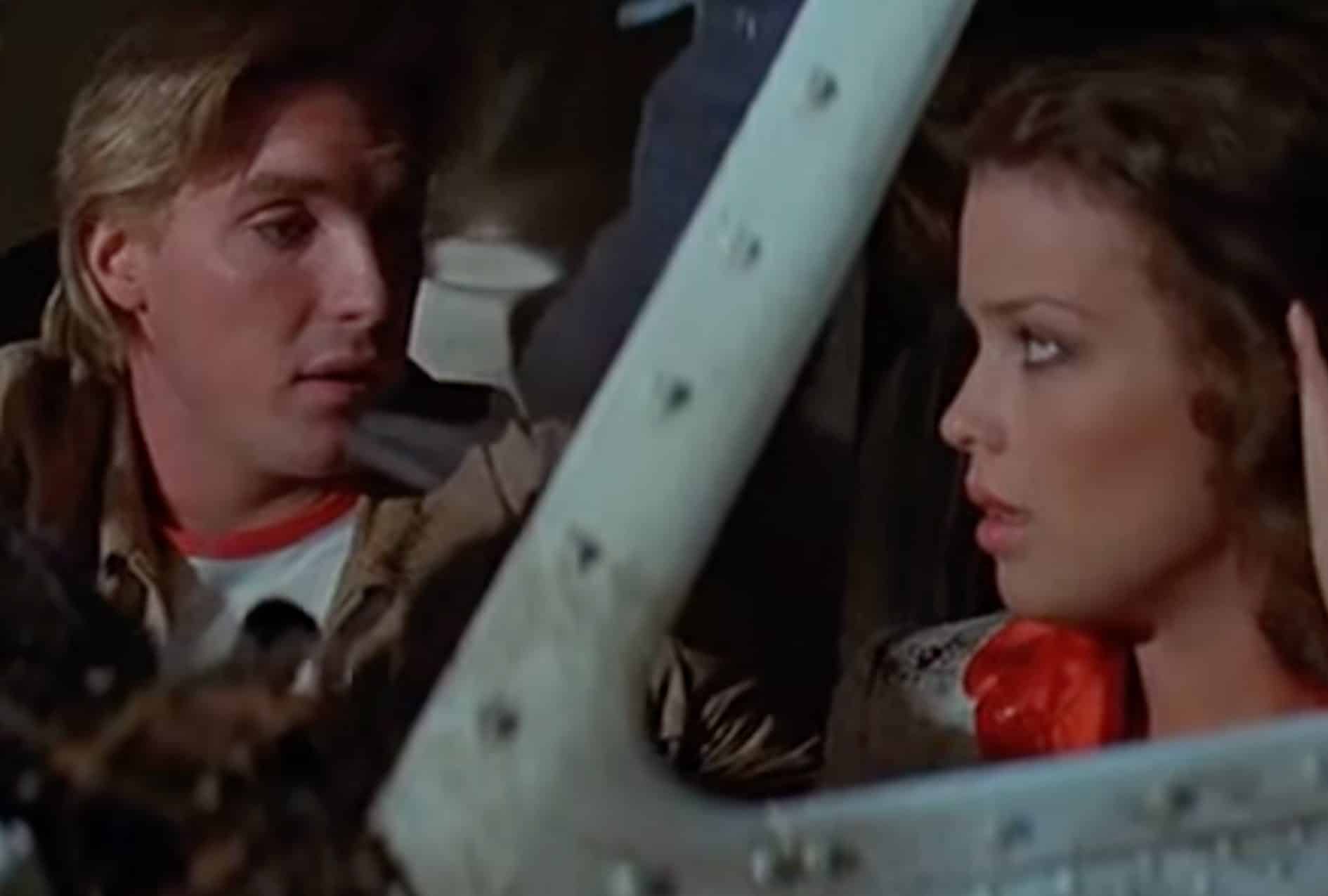
Sam J Jones’ Flash and Melody Anderson’s Dale meet when they are fellow passengers on a small aeroplane headed to New York. This wasn’t always the plan, though. In an earlier draft of the screenplay, Flash and Dale would have met the night before their ill-fated flight whilst in a Canadian resort town called Dark Harbor.
This initial meeting was cut from the script before production began, and Flash and Dale’s meeting was re-written. However, this script change was apparently forgotten later on, as in the scene when Flash is a prisoner of Ming about to be executed, Flash and Dale try to pretend it’s only a dream; Dale remarks, “we’ll wake up any minute in Dark Harbor and have a laugh about this.”
6. The camera angles slowly change to emphasise Ming’s downfall

Flash Gordon has faced some harsh criticism over the years, with some accusing it of being stupid. However, eagle-eyed viewers may have noticed a rather clever directorial choice which is so subtle, even those who have watched the film every year for decades might not have spotted it – and it all relates to how Ming the Merciless is filmed.
In Max Von Sydow’s earliest scenes as Ming, director Mike Hodges ensures the actor is always shot from below, which puts him above the audience and emphasises his power. Later, as Flash begins to unite his forces to combat Ming, the camera switches to filming Ming face-on, at an equal level with the audience. Eventually he is shot from above, emphasising how he has fallen from power.
5. Richard O’Brien was badly behaved on set

Richard O’Brien, best known as the writer of cult stage musical The Rocky Horror Show and its hit movie adaptation The Rocky Horror Picture Show, has a supporting role in Flash Gordon as Fico, one of the Tree Men. This was one of O’Brien’s few major film roles, and it seems the actor and writer was not a big fan of the working conditions.
Apparently O’Brien got very bored during filming and started causing trouble on the set, which didn’t go down too well with the other actors. He regularly sat on the personalised chairs of the principal cast members, behaviour which wasn’t curbed at all by the film’s director, Mike Hodges. This is because Hodges and O’Brien were good friends, a fact which annoyed the other cast members who grew irritated with the actor.
4. Sam J. Jones got the part after being spotted on TV’s The Dating Game

Prior to Flash Gordon, Sam J. Jones’ only film credit was a small part in 1979’s hit comedy 10. However, it wasn’t this performance that put him in the running for Flash; instead, it was the actor’s appearance on TV’s The Dating Game, on which he caught the eye of producer Dino De Laurentiis’s mother-in-law.
Being a good son-in-law, De Laurentiis agreed to reach out to Jones and give him a shot, although the actor still had to go through a lengthy audition process before securing the role. It helped that, like his character, Jones was a football player, at the time a semi-pro with the Seattle Flyers. In addition, Jones had previously been in the Marine Corps, and had modelled for Playgirl magazine.
3. Klytus was an all-new character who didn’t appear in the Flash Gordon comics

Viewers of Flash Gordon will doubtless remember Ming’s right-hand man, Klytus; after all, his name is the very first word we hear spoken in the film. However, the introduction of the golden-masked villain might have come as a surprise to fans of the old Flash Gordon comic strips, as – unlike virtually every other major character in the film – Klytus was not part of the original story.
Portrayed by British actor Peter Wyngarde (otherwise best known as TV’s Jason King), Klytus was an original character created specifically for the film, who was not part of Alex Raymond’s original script. It’s not clear, however, whether he was the creation of screenwriter Lorenzo Semple Jr or previous writer Michael Allin, the latter of whom wrote the initial story from which the film was built.
2. Sam J. Jones has since become a professional bodyguard
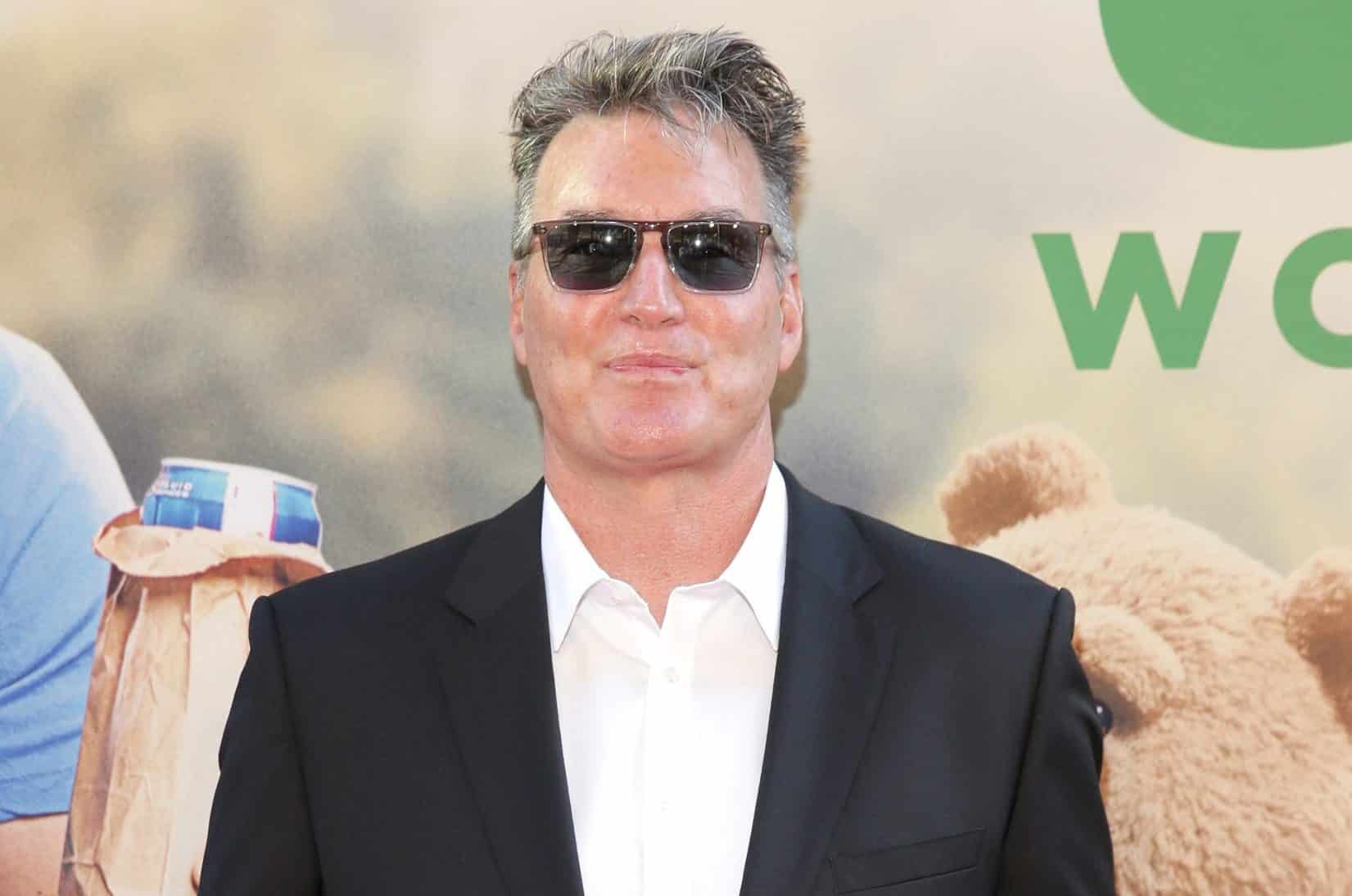
Flash Gordon didn’t launch Sam J. Jones to the successful leading man career that might have been expected. After spending more than 20 years working primarily in TV guest roles and low-budget films, Jones eventually grew tired of the acting game and decided to draw on his military beginnings to pursue a very different line of work.
These days, Jones primarily earns his keep in private security. He runs his own firm out of San Diego, and also works for hire as a personal bodyguard, reportedly doing much of his work in Mexico and New Orleans in the wake of Hurricane Katrina. Outside of this, Jones is still a regular at fan conventions and takes the occasional acting role (including his appearances as himself in the Ted movies).
1. Acclaimed playwright John Osborne has a cameo appearance

British viewers who were kids in the 80s may recognise TV star Peter Duncan for his cameo in the Arboria sequence, but there’s another, more historically significant figure in this scene who you might not recognise. The High Priest of Arboria is played by no less a figure than John Osborne, one of the most esteemed British writers and playwrights of the 20th century.
Considered part of the ‘Angry Young Men’ literary movement, Osborne was famed for his realistic, socially conscious dramas, most famously with the play Look Back in Anger. This makes him all the more unlikely a figure to appear in a camp, space age melodrama like Flash Gordon. However, Osborne took the role as he was friends with director Mike Hodges, who previously cast him in 1971 thriller Get Carter.

